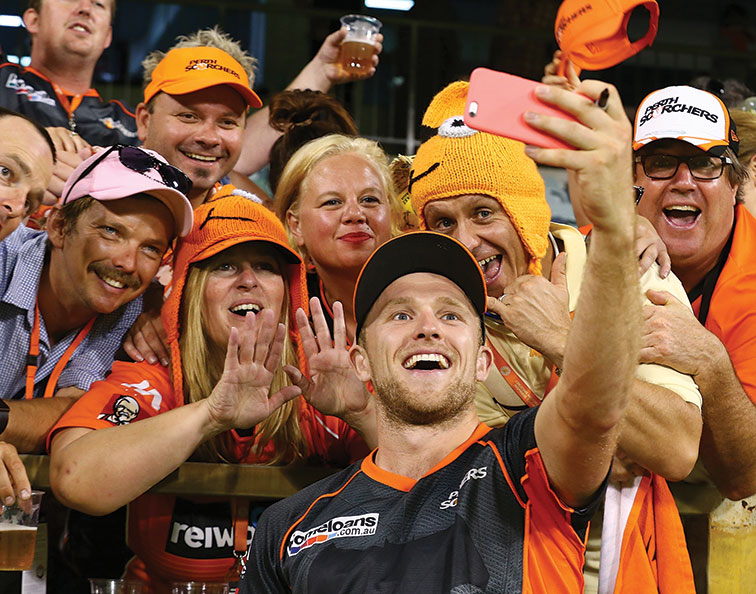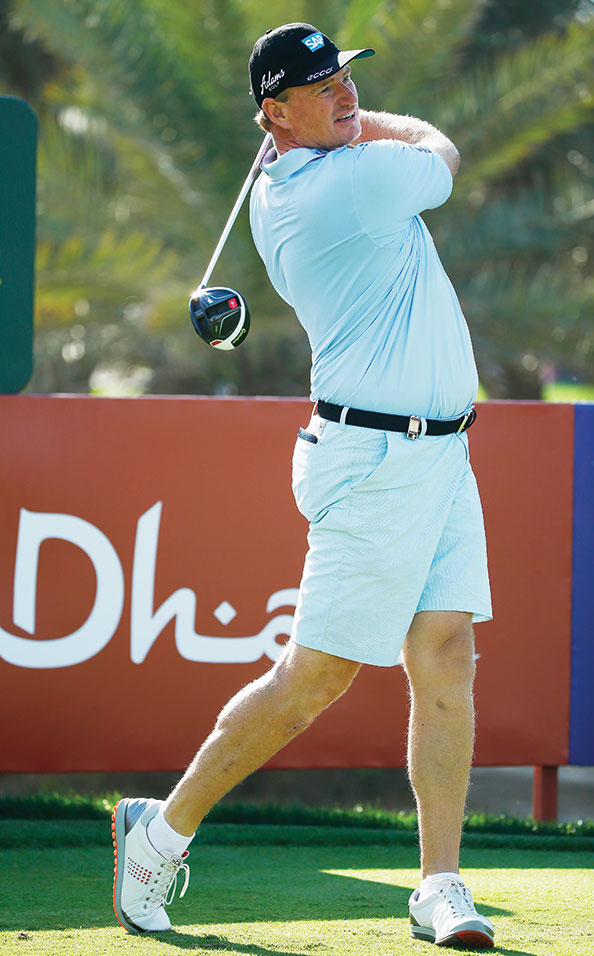AUSTRALIAN golf appears to be on a roll. With Jason Day and Adam Scott cemented in the world’s top 10, the sport has two dominant local players at the forefront of the men’s game.
You could conclude it’s a catalyst for another boom, the like of which we witnessed when Greg Norman transformed golf into a sport that mesmerised Australians.
We should be so lucky. The reality is that Australian golf is in a bit of a ‘holding pattern’. Playing numbers (participation) have stabilised, the industry (equipment distributors and golf clubs) has consolidated while it has lost the Australian Masters from next summer’s schedule.
Until recently, the three ‘majors’ of men’s professional golf – the Australian Open (administered by Golf Australia), Australian PGA Championship (PGA of Australia) and Australian Masters (IMG) – prospered on the back of state-government largesse. But it seems the Victorian State Government would rather support a one-off exhibition such as the World Cup of Golf at the expense of an iconic Melbourne tournament that has been around for 37 years.
Collectively, the PGA Tour of Australasia can’t afford to be complacent as the behemoth that is the US PGA Tour continues to expand its reach. OneAsia, which was meant to be a salvation for the Australian tour, has silently disappeared into the ether.
Golf fans can tune into Foxtel and watch the world’s best players compete each week on the US PGA Tour. Viewers get a brilliant high-definition experience with hi-tech graphics (slow-motion replays and shot tracking) plus incisive commentary.
Gone are the days when Graeme Rowland headed the Seven Network’s broadcasts of Australian golf with 30 cameras at his disposal. Channel Seven’s coverage of the Australian Open and Masters was world-class in its delivery and production values.
But with frugal commercial broadcasters no longer driving domestic golf, administrators need to conceive ways to make our tournaments more dynamic. Golf Victoria has led the way, staging the men’s Victorian Open in conjunction with the women’s championship. It’s been warmly received at Thirteenth Beach on the Bellarine Peninsula, where the men and women play in alternate groupings.

Golf can learn a lot from Australian cricket, which has embraced the Twenty 20 format, technology and initiatives to attract new fans. The Big Bash League – once derided for its brevity and inconsequential nature – has created unprecedented interest through spectacular shotmaking and a capacity to engage with fans.
Rather than bemoan the financial clout of the Indian Premier League, organisers of the Big Bash have come up with a product that is technically superior. Bails light up when the stumps are broken. ‘Miked up’ cricketers deliver their thoughts on a match in progress in real time.
By contrast, the summer of golf lacks hype, publicity and innovation. The exception was 2013 when Adam Scott’s tour de force with a green jacket transcended the game. That should tell us there needs to be a sense of occasion, a little more ‘joie de vivre’ to generate interest with the mainstream media and sports-loving public.
We’re never going to compete with the US PGA Tour, where tournament purses dwarf what’s on offer in Australia. But too much pre-tournament news for our men’s tournaments focuses upon player announcements.
It’s a real coup when Jordan Spieth or Rory McIlroy commits to play Down Under. But all too frequently, a marquee player turns out to be a flop (for instance, Ernie Els’ withdrawal from the Masters or Brandt Snedeker’s error-riddled performance at the PGA).
Bluntly, the PGA Tour of Australasia needs to engage more with golfers. Six months out from this year’s summer of golf, here are some suggestions to spark interest, enhance the stature of our biggest tournaments and make the coverage a bit more dynamic.
1. Reintroduce The Party Hole
Desired Outcome: To create atmosphere at the tournament venue, which excites spectators on the course and viewers of the TV broadcast.
Australian golf is conservative and a bit gun shy – with good reason. Administrators flirted with jazzing up the sport a decade ago. Paul McNamee, former tournament director of Golf Australia, introduced a ‘Party Hole’ for the 2007 Australian Open at Royal Sydney. It was a bold initiative based on the rowdy 16th hole at TPC Scottsdale during the Phoenix Open, an event that attracts in excess of 150,000 spectators annually.
But a national championship at one of Sydney’s most distinguished private clubs wasn’t the time, or the place, to introduce such a flamboyant idea. It turned sour when Robert Allenby copped abuse from drunken fans in the marquee behind the 17th green.
Allenby had appeared to relish the Party Hole on Thursday when he wore pink earmuffs to the delight of the gallery. But it went awry on Sunday when a heckler taunted him about shedding tears for his dying mother at the previous week’s Australian Masters: “That’s all right mate, your mummy’s not here this week, you don’t have to cry.”
It’s almost as if that tasteless incident – and the recriminations that followed – ushered in a cautious mindset for our three men’s tournaments. Administrators appear risk-averse – fearful of a backlash from leading Australian players if they were to try something out of the ordinary.
But it needn’t be that way. Think back to the Australian Masters in the 1980s and 1990s when Norman was in his prime. The 18th at Huntingdale Golf Club was referred to as ‘Beer Can Alley’ with boisterous fans in grandstands and corporate marquees lining the fairway. The players loved the atmosphere.
The PGA Championship and Masters have the most to gain – and little to lose – by reintroducing a ‘Party Hole’. It’s not as if the pros would refuse to play because of a boisterous little shindig.
A well-conceived Party Hole has the potential to be an exciting focal point of the tournament.
2. Initiate Continuous Putting
Desired Outcome: To speed up play and set an example for club/social golfers to follow.
At the start of the football season, the AFL introduced a 30-second ‘Shot Clock’ as players kicked for goal from a set shot. The rule was designed to make the game more fluent. If a dynamic sport such as AFL is concerned about timewasting, then surely golf should have a hard look at itself.
Watching professionals dither about on the greens is the most tedious part of a golf telecast. The time it takes to mark, lift, move away and then replace a ball is something that should be addressed.
Putting professional golfers on the clock to speed up play has been problematic in the past. It’s hard to police and difficult to enforce in an even-handed manner. A more efficient solution may be to initiate continuous putting.
How would it work? Once a player steps forward to putt, he is obliged to continue putting until the ball is holed. When the ball comes to rest after a missed putt, the player would have, say, 15 seconds to strike the next putt. I’d hazard a guess it could save up to 30 minutes a round if adopted by club/social golfers.
Would continuous putting affect the integrity of the professional game? Maybe, but instead of the pros worrying about ‘through lines’ and other golf etiquette, they should be addressing the excessive amount of time it takes to play the game – a reason for golf’s decline in participation around the world.
Besides, gone are the days when spike marks would cause a putt to deviate off line. The transition from metal spikes to so-called soft spikes has reduced wear and tear and – as a result – professional golf is less governed by chance.
Consider what Geoff Ogilvy had to say about the putting surfaces at The Australian Golf Club during last year’s Australian Open. “The greens are great to putt on. You feel like the first group out there on every hole. There isn’t any evidence that anyone else has been out there.”
So stop dithering about on the greens.
3. Stage a Father/Son Challenge
Desired Outcome: To show golf is a sport for the ages as well as a game that can bring families together in a time-conscious world.
We shouldn’t take for granted the loyalty shown by leading professionals to come back home and play in Australia at the end of a long year. Adam Scott faces the balancing act of needing to play globally, especially Asia, to satisfy his sponsors (Titleist, Rolex, Uniqlo) with the need to have a proper off-season so he’s ready for the following year. It’s unrealistic to expect him to play all the Australian tournaments.
So if you’re competing for the presence of Scott or Day, you need to have a better pickup line than simply asking them to play the Open/PGA/Masters out of loyalty. It requires a bit of lateral thinking.

Scott has shown his desire to put something back into the game (and the community through the Adam Scott Foundation). What better cause than junior golf? From the age of 5, Adam began playing with his father Phil on the par-3 layout at North Adelaide Golf Course.
Imagine staging a Father/Son Challenge on the eve of the Australian Open. Get Adam and Phil Scott involved. Invite Jason to bring his son Dash for a hit. Play it at Bondi Golf Club, a picturesque little track (par-28) just a kilometre down the road from Royal Sydney. It would serve as a better backdrop for a photo opportunity than a stock-standard press conference in the media tent.
With a database of more than 400,000 club members, Golf Australia could stage a nine-hole exhibition for dads and sons to play alongside Adam and Jason. Include mothers and daughters. Grandparents, too.
Juniors are the future of the game. A Father/Son Challenge would be a step in the right direction by acknowledging the importance they play in the sport’s regeneration.
4. Adopt Short Pants
Desired Outcome: To make it known that golf is hip and isn’t mired in rules and regulations tailored for ‘old white guys’.
In a refreshing twist, players wore short pants during practice days and pro-am for the first time on the European Tour at this year’s Abu Dhabi HSBC Golf Championship in January. The new initiative was implemented to help “modernise the game”, according to the tour’s chief executive Keith Pelley.

Allowing shorts in tournament play is the next bridge to cross. The year-ending PGA Championship at RACV Royal Pines – now co-sanctioned with Europe – would be an ideal tour stop to break away from the sport’s traditional garb of polo shirts and pleated trousers.
With daily temperatures in December of 25 degrees and relative humidity at 70 per cent, it makes sense to allow players to wear shorts on the Gold Coast. Taking care of the players has long been an objective of the PGA since its convivial days at Coolum Resort. It’s unlikely there would be any objection from the European Tour, which would surely welcome a move that highlights its progressive attitude by comparison with the myopic American approach to tournament golf.
5. Create a Charity Drive
Desired Outcome: To bring more talking points to the TV broadcast and raise awareness about golf’s positive contribution to the wider community.
Golf doesn’t make enough of a fuss about the role it plays in charitable contributions. No other sport can say it raises more money for charity than golf. The US PGA Tour, for instance, has donated more than $US2.2 billion since its first charitable contribution of $10,000 at the 1938 Palm Beach Invitational.
Golf clubs around Australia raise funds for many fine causes, ranging from Make-A-Wish to Diabetes. But a lot of this goes unreported, most probably due to the relatively small amounts involved. We should take the lead from the US PGA Tour and add up the various amounts (using the grand total to persuade/lobby governments for assistance when required).
The PGA Tour of Australasia has an opportunity to show its charitable side during an actual golf tournament. Imagine raising funds with a nearest-the-pin contest. Players could nominate their favourite charity, which would be rewarded when they hit a tee shot into a circular ‘Eagle’s Nest’ on a par 3. A long drive or straightest drive competition could feature in other rounds of the tournament.
6. Hold a Calcutta / Sweepstakes
Desired Outcome: To engage with golf clubs from the state hosting the tournament.
‘Calcutta’ was a wonderful initiative introduced at the Women’s Australian Open in Adelaide. All 146 affiliated golf clubs in South Australia were randomly drawn a player competing in the championship. Morgan-Cadell Golf Club, whose player won the Open, received a flag signed by the champion (Japan’s Haru Nomura).
That’s the sort of idea that should be expanded, especially through rural clubs where the lineage with the professional game can be non-existent.




